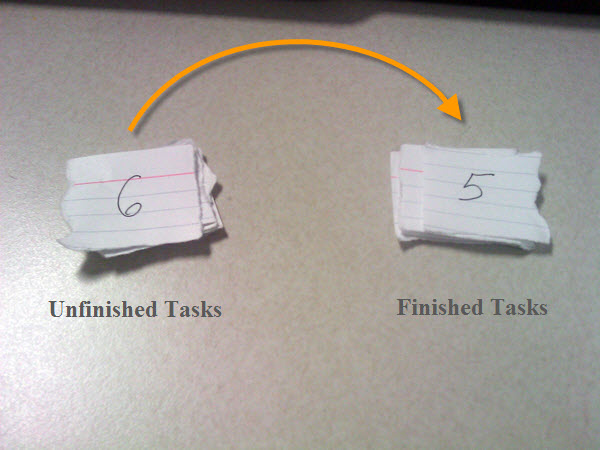Productivity Tip: Paper Number Piles
Last week I discovered a technique for increasing productivity at work. It's so simple it's almost funny, but it is working. I tore up an index card into 10 little squares, numbering them one through ten. In the morning, before I launch into the work of the day, I write down the top ten tasks I want to accomplish for that day. As I finish the first task, I take the paper square number 1 and move it to a pile on the right. When I finish the second task, I take the paper square number 2 and move it to the pile on the right. And so on until I manage to move all the paper squares to the pile on the right.

The paper squares help me focus on the task at hand. My world is one of increasing distraction. Not ten minutes goes by that I'm not distracted by incoming email messages, phone calls, instant messages, team blog posts, RSS feeds, Twitter posts and replies, ping pong, and more. Having a little piece of paper in front of me (e.g., #6) helps me remember what my task is and keeps me motivated to work through all ten.
In numbering the tasks, avoid writing anything that can't be accomplished in an hour. For example, if you're working on a brochure, which could easily take you all day, break down the tasks into one hour increments. For example, #1 Insert Images, #2 Write First Paragraph Copy, #3 Format Print Layout, #4 Finish Copy for Second Column, and so on. By keeping the tasks finishable, it keeps you motivated.
When you push through five of your tasks before noon, you feel on top of the world. Conversely, if it's 3 p.m. and you're only on task #4, you can feel that your day hasn't been productive. (This is why you need to keep the tasks relatively small.)
The core idea behind the two piles of paper here, besides breaking down large tasks into small ones (which, when completed, makes you feel good), is to provide a visual object to focus your attention, so that even after a brief distraction, you look down, see #6, and know exactly what you should be working on.
Every time you complete a task and move a piece of paper to the pile on the right, it feels like you're truly getting things done. Conversely, if you consistently can't work through even half of the ten tasks, it makes you feel slow, behind, and inefficient. It's kind of a polarizing pat-on-the-back or slap-in-the-face effect.
About Tom Johnson

I'm an API technical writer based in the Seattle area. On this blog, I write about topics related to technical writing and communication — such as software documentation, API documentation, AI, information architecture, content strategy, writing processes, plain language, tech comm careers, and more. Check out my API documentation course if you're looking for more info about documenting APIs. Or see my posts on AI and AI course section for more on the latest in AI and tech comm.
If you're a technical writer and want to keep on top of the latest trends in the tech comm, be sure to subscribe to email updates below. You can also learn more about me or contact me. Finally, note that the opinions I express on my blog are my own points of view, not that of my employer.

